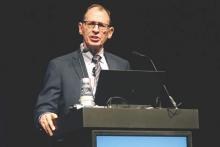The effect of PEGlispro on triglycerides appeared to differ according to the insulin treatment patients had previously received. In patients with type 2 diabetes who were insulin naive, there was no “essentially no change” in triglycerides Dr. Hoogwerf said. Although triglycerides were higher in the PEGlispro group, this could be because both glargine and NPH were associated with decreased levels, he said. In insulin-exposed type 2 diabetics, however, there was an increase in triglycerides when compared with glargine with both basal only and basal-bolus regimens. In those with type 1 diabetes, triglycerides were also higher, an effect that could be from switching the prior basal insulin, he suggested.
Changes on HDL and LDL cholesterol were minimal overall, he maintained, with little effect also on apolipoproteins and fasting free fatty acids. During the discussion, however, it was noted by one delegate that PEGlispro did not appear to be a very “lipid-friendly” drug, but said that it was the “overall package” of effects that mattered.
Dr. Richard Bergenstal of the International Diabetes Center in Minneapolis presented a meta-analysis of data on the cardiovascular safety of the drug. This included data on more than 5,800 patients from two phase II and six phase III studies of PEGlispro vs. an active comparator of glargine or NPH. The overall rate of major adverse cardiovascular events (MACE) – the primary composite endpoint incorporating cardiovascular death, stroke, myocardial infarction, and unstable angina with hospitalization – was 1.4% vs. 1.8%/100 patient-years, respectively, he said.
The overall hazard ratio for at least one MACE comparing PEGlispro with an active comparator was 0.82, with a 95% confidence interval of 0.53-1.27, and the subgroup analyses “did not identify any population of patients with increased treatment-associated risk.”
Eli Lilly funded the studies. Dr. Davies and Dr. Bergenstal have acted as advisory board members, speakers, or received research funding from Eli Lilly as well as several other pharmaceutical companies. Dr. Hoogwerf is an employee of, and minor stockholder in, Eli Lilly. Dr. Bailey had no financial disclosures relevant to his comment.


